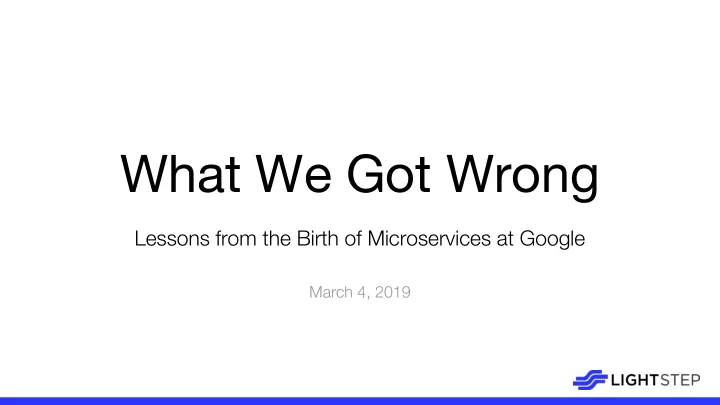

What We Got Wrong Lessons from the Birth of Microservices at Google March 4, 2019
Part One: The Setting
Still betting big on the Google Search Appliance
“Those Sun boxes are so expensive!”
“Those linux boxes are so unreliable!”
“Let’s see what’s on GitHub first…” – literally nobody in 2001
“GitHub” circa 2001
Engineering constraints - Must DIY: - Very large datasets - Very large request volume - Utter lack of alternatives - Must scale horizontally - Must build on commodity hardware that fails often
Google eng cultural hallmarks, early 2000s - Intellectually rigorous - “Autonomous” (read: often chaotic) - Aspirational
Part Two: What Happened
Cambrian Explosion of Infra Projects Eng culture idolized epic infra projects (for good reason): - GFS - BigTable - MapReduce - Borg - Mustang (web serving infra) - SmartASS (ML-based ads ranking+serving)
Convergent Evolution? Common characteristics of the most-admired projects: - Identification and leverage of horizontal scale-points - Well-factored application-layer infra (RPC, discovery, load-balancing, eventually tracing, auth, etc) - Rolling upgrades and frequent (~weekly) releases Sounds kinda familiar…
Part Three: Lessons
Lesson 1 Know Why
Org design, human comms, and microservices You will inevitably ship your org chart
Accidental Microservices - Microservices motivated by planet-scale technical requirements - Ended up with something similar to modern microservice architectures … - … but for different reasons (and that eventually became a problem)
What’s best for Search+Ads is best for all!
What’s best for Search+Ads is best for all! just the massive, planet-scale services
“But I just want to serve 5TB!!” – tech lead for a small service team
Architectural Overlap Planet-scale Software apps with M i c r o s e r v i c e s systems software lots of developers
Lesson 2 “Independence” is not an Absolute
Hippies vs Ants
More Ants!
Dungeons and Dragons!!
Microservices Platforming: D&D Alignment Good Platform decisions are “Our team is going to multiple choice build in OCaml!” Lawful Good Chaotic Good kubernetes Lawful Chaos True Neutral AWS Lambda <redacted> Lawful Evil Chaotic Evil Evil
Lesson 3 Serverless Still Runs on Servers
An aside: what do these things have in common? All 100% Serverless!
About “Serverless” / FaaS Numbers every engineer should know Latency Comparison Numbers (~2012) ---------------------------------- L1 cache reference 0.5 ns Branch mispredict 5 ns L2 cache reference 7 ns 14x L1 cache Mutex lock/unlock 25 ns Main memory reference 100 ns 20x L2 cache, 200x L1 cache Compress 1K bytes with Zippy 3,000 ns 3 us Send 1K bytes over 1 Gbps network 10,000 ns 10 us Read 4K randomly from SSD* 150,000 ns 150 us ~1GB/sec SSD Read 1 MB sequentially from memory 250,000 ns 250 us Round trip within same datacenter 500,000 ns 500 us Read 1 MB sequentially from SSD* 1,000,000 ns 1,000 us 1 ms ~1GB/sec SSD, 4X memory Disk seek 10,000,000 ns 10,000 us 10 ms 20x datacenter roundtrip Read 1 MB sequentially from disk 20,000,000 ns 20,000 us 20 ms 80x memory, 20X SSD Send packet CA->Netherlands->CA 150,000,000 ns 150,000 us 150 ms Notes ----- 1 ns = 10^-9 seconds 1 us = 10^-6 seconds = 1,000 ns 1 ms = 10^-3 seconds = 1,000 us = 1,000,000 ns Credit ------ By Jeff Dean: http://research.google.com/people/jeff/ Originally by Peter Norvig: http://norvig.com/21-days.html#answers
About “Serverless” / FaaS Main memory reference: 100 nanoseconds Round trip within same datacenter: 500,000 nanoseconds
Real data! Hellerstein et al.: “Serverless Computing: One Step Forward, Two Steps Back” - Weighs the elephants in the room - Quantifies major issues, esp re service comms and function lifecycle
Lesson 4 Beware Giant Dashboards
We caught the regression!
… but which is the culprit?
# of reasons things break Must reduce the search space! # of things your users actually care about # of microservices
All of observability in two activities 1. Detection of critical signals (SLIs) 2. Explaining variance variance over time “Visualizing everything that might vary” is a terrible way to explain variance. variance in the latency distribution
Lesson 5 Distributed Tracing is more than Distributed Traces
Distributed Tracing 101 A single distributed trace Microservices
There are some things I need to tell you…
Trace Data Volume: a reality check app transaction rate x # of microservices x cost of net+storage x weeks of retention ----------------------- way too much $$$$
The Life of Trace Data: Dapper Stage Overhead affects… Retained Instrumentation Executed App 100.00% Buffered within app process App 000.10% Flushed out of process App 000.10% Centralized regionally Regional network + storage 000.10% Centralized globally WAN + storage 000.01%
The Life of Trace Data: Dapper “Other Approaches” Stage Overhead affects… Retained Instrumentation Executed App 100.00% Buffered within app process App 100.00% Flushed out of process App 100.00% Centralized regionally Regional network + storage 100.00% Centralized globally WAN + storage on-demand
But wait, there’s more! - Visualizing individual traces is necessary but not sufficient - Raw distributed trace data is too rich for our feeble brains - A superior approach: - Ingest 100% of the raw distributed trace data - Measure SLIs with high precision (e.g., latency, errors) - Explain variance with biased sampling and “real” stats Meta: more detail in my other talk today and Weds keynote
Almost Done…
Let’s review… - Two drivers for microservices: what are you solving for? - Team independence and velocity - “Computer Science” - Understand the appropriate scale for any solution - Hippies vs Ants - Services can be too small (i.e., “the network isn’t free”) - Observability is about Detection and Refinement - “Distributed tracing” must be more than “distributed traces”
Thank you! Ben Sigelman, Co-founder and CEO twitter: @el_bhs email: bhs@lightstep.com PS: LightStep announced something cool today! I am friendly and would love to chat… please say hello, I don’t make it to Europe often!
Recommend
More recommend